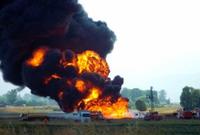-
It will take 11 trillion gallons to replenish California drought losses: NASA
Since 2011, the Sacramento and San Joaquin river basins decreased in volume by four trillion gallons of water each year (fifteen cubic kilometers). This is more water than California’s thirty-eight million residents use each year for domestic and municipal purposes. About two-thirds of the loss is due to depletion of groundwater beneath California’s Central Valley. It will take about eleven trillion gallons of water (forty-two cubic kilometers) — around 1.5 times the maximum volume of the largest U.S. reservoir — to recover from California’s continuing drought, according to a new analysis of NASA satellite data.
-
-
Placing people in affordable homes within days, not years, after major storms
On Monday, Housing and Urban Developmentsecretary Julian Castro toured the core of a house in Brownsville, Texas, as part of the RAPIDO project, which local officials hope will one day become the model for housing recovery after a major storm. The house is part of a $2 million pilot project which relies on low construction expenses and affordable labor to get people in affordable homes within days of a major disaster instead of years. While hundreds of affordable homes have been built since Hurricane Dolly and Ike destroyed a vast portion of the Texas Gulf Coast in 2008, many residents are still waiting for houses already funded with federal disaster money.
-
-
Industry: Multiple redundant and back-up systems make nuclear plants safer than ever
Nuclear plants receive what supporters of nuclear power regard as an unfair amount of scrutiny and concern for their safety, but industry experts say that plant equipment and plant operations are highly regulated to minimize risks.All U.S. nuclear plants are now storing emergency pumps, generators, battery banks, chargers, compressors, and hoses at off-site locations near the plants to protect against floods, industry insiders say.Working in a nuclear plant is much safer than working in a paper mill or a chemical plant, according to Jim Krafty, a Nuclear Regulatory Commission (NRC) resident senior inspector at the Beaver Valley nuclear power plant in Shippingport, Pennsylvania.
-
-
Better forecasts for rain-on-snow flooding
Many of the worst West Coast winter floods pack a double punch. Heavy rains and melting snow wash down the mountains together to breach river banks, wash out roads and flood buildings. These events are unpredictable and difficult to forecast. Yet they will become more common as the planet warms and more winter precipitation falls as rain rather than snow. Mountain hydrology experts are using the physics behind these events to better predict the risks.
-
-
Be prepared: What to do if an asteroid is heading our way

Last month, experts from European Space Agency’s (ESA) Space Situational Awareness (SSA) program and Europe’s national disaster response organizations met for a two-day exercise on what to do if an asteroid is ever found to be heading our way. The exercise considered the threat from an imaginary, but plausible, asteroid, initially thought to range in size from twelve meters to thirty-eight meters — spanning roughly the range between the 2013 Chelyabinsk airburst and the 1908 Tunguska event — and travelling at 12.5 km/s. Teams were challenged to decide what should happen at five critical points in time, focused on 30, 26, 5, and 3 days before and one hour after impact.
-
-
2008 Turkish oil pipeline explosion may have been Stuxnet precursor

The August 2008 Baku-Tbilisi-Ceyhan (BTC) oil pipeline explosion in Refahiye, eastern Turkey, was ruled at the time to be an accident resulting from a mechanical failure, which itself was a result of an oversight by Turkish government’s supervisors. Western intelligence services concluded that the explosion was the result of a cyberattack. According to people familiar with an investigation of the incident, hackers had infiltrate the pipeline’s surveillance systems and valve stations, and super-pressurized the crude oil in the pipeline, causing the explosion.
-
-
Better defense barriers and technologies for better protection against floods
Hurricanes are devastating. Aside from the high, sustained wind speeds, they usually bring with them heavy rain, which can quickly lead to the breaching of flood defenses in susceptible areas. Now, U.S. and U.K. researchers have reviewed hurricane flood defense barriers and technologies with a view to helping engineers find improved designs.
-
-
Coastal defenses could contribute to flooding with sea-level rise
A combination of coastal defenses and rising sea levels could change typical U.K. tidal ranges, potentially leading to a higher risk of flooding, say scientists. The researchers wanted to find out how tides around the United Kingdom might respond to changes in sea level over the next century depending on the level of coastal defenses in place. Their study shows for the first time that local coastal defenses, such as sea walls, could cause tides to change dramatically. It suggests flood defenses need to be reassessed on an international scale as they may lead to an increased risk of flooding.
-
-
Nuclear power should play “substantial role” in mitigating climate change: Environmental scientists
Leading conservation scientists from around the world have called for a substantial role for nuclear power in future energy-generating scenarios in order to mitigate climate change and protect biodiversity. In an open letter to environmentalists with more than sixty signatories, the scientists ask the environmental community to “weigh up the pros and cons of different energy sources using objective evidence and pragmatic trade-offs, rather than simply relying on idealistic perceptions of what is ‘green’.”
-
-
FBI moves cyberthreats to top of law-enforcement agenda
FBI director James Comey said combatting cybercrime and other cyber threats are now top FBI priority. “It (the Internet) is transforming human relationships in ways we’ve never seen in human history before,” Comey said. “I see a whole lot of hacktivists, I see a whole lot of international criminal gangs, very sophisticated thieves,” he added. “I see people hurting kids, tons of pedophiles, an explosion of child pornography.” In October Comey urged Congress to require tech companies to put “backdoors” in apps and operating systems. Such a move would allow law enforcement officials to better to monitor suspected criminals who often escape the law using encryption and anti-surveillance computer software.
-
-
Congressional funding allows partial roll-out of Calif. seismic early warning system
California officials applauded the U.S. Senate approval of the $1.1-trillion spending package, which allocated $5 million to fund expansion of the state’s earthquake early-warning system dubbed ShakeAlert.In 2015, a select number of schools will receive earthquake alerts to warn students and teachers to drop and cover before shaking begins, fire stations will be alerted to open their garage doors before electricity goes out and prevents doors from opening, and some hospitals will receive notice to suspend surgeries.
-
-
Cyber whodunnit: North Korea prime suspect but there are many potential culprits
Many suspect North Korea to be behind the attack on Sony Pictures. North Korea quite possibly has motive, means, and opportunity to carry out this attack on Sony, but as with any successful prosecution, that isn’t enough. We need evidence. We will have to wait for the detailed forensic work to complete before we stand a realistic chance of knowing for certain. That may or may not be forthcoming, but in the meantime we should consider what this event tells us about the balance of power in cyberspace. In a world in which major disruption can be caused with scant resources and little skill, all enemies are a threat. North Korea might be the rogue state that everyone loves to hate but there are plenty of others who could have done it. There is no longer a tiered approach of superpowers fighting proxy wars in smaller, developing nations. Now those developing nations can fight back, and you might not even know it was them.
-
-
Power grids in coastal U.S. cities increasingly vulnerable as a result of climate change
Cities such as Miami are all too familiar with hurricane-related power outages. A new analysis finds, however, that climate change will give other major metropolitan areas a lot to worry about in the future. Johns Hopkins University engineers created a computer model to predict the increasing vulnerability of power grids in major coastal cities during hurricanes. By factoring historic hurricane information with plausible scenarios for future storm behavior, the team determined which of twenty-seven cities, from Texas to Maine, will become more susceptible to blackouts from future hurricanes. The team’s analysis could help metropolitan areas better plan for climate change.
-
-
House approves 4-year extension of chemical facility safety legislation
On 11 December the House approved a 4-year reauthorization of DHS’s Chemical Facility Anti-Terrorism Standardsprogram (CFATS), meant to protect U.S. chemical facilities from terrorist attacks. President Barack Obama is expected to sign the bill(H.R. 4007). Implementing the CFATS program will cost roughly $349 million over fiscal years 2015 to 2019. The CFATS, authorized in Section 550 of the 2007 DHS Appropriations Act, requires industrial facilities with certain levels of use or storage of chemicals to submit information about their chemical holdings to DHS, assess their vulnerabilities, and submit plans to address those vulnerabilities and secure their chemical holdings.
-
-
Impact of solar storm on U.S. infrastructure cannot be predicted with certainty
Of the many threats to the U.S. electric grid, from cyberattacks to terrorism, industry experts agree that the most catastrophic, yet least likely to occur, threat is a magnetic space storm which could shut down the grid and cause other infrastructure to fail. Previous large scale solar storms include the 1859 Carrington Event — the strongest storm on record — and a March 1989 coronal mass ejection which caused a 9-hour blackout in Quebec.
-
More headlines
The long view
Helping Strengthen America’s Critical Infrastructure
Everyday life depends on a robust infrastructure network that provides access to running water, communications technology and electricity, among other basic necessities. The experts who keep our national infrastructure secure and resilient also need a strong network to share their knowledge and train the next generation of professionals capable of solving complex infrastructure challenges.
AI and the Future of the U.S. Electric Grid
Despite its age, the U.S. electric grid remains one of the great workhorses of modern life. Whether it can maintain that performance over the next few years may determine how well the U.S. competes in an AI-driven world.
Using Liquid Air for Grid-Scale Energy Storage
New research finds liquid air energy storage could be the lowest-cost option for ensuring a continuous power supply on a future grid dominated by carbon-free but intermittent sources of electricity.
Enhanced Geothermal Systems: A Promising Source of Round-the-Clock Energy
With its capacity to provide 24/7 power, many are warming up to the prospect of geothermal energy. Scientists are currently working to advance human-made reservoirs in Earth’s deep subsurface to stimulate the activity that exists within natural geothermal systems.
Experts Discuss Geothermal Potential
Geothermal energy harnesses the heat from within Earth—the term comes from the Greek words geo (earth) and therme (heat). It is an energy source that has the potential to power all our energy needs for billions of years.
